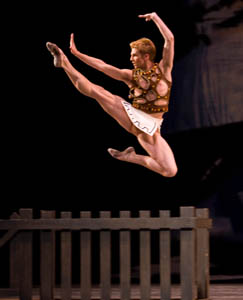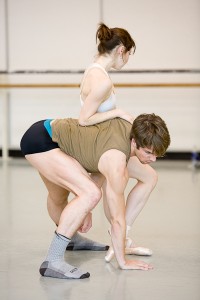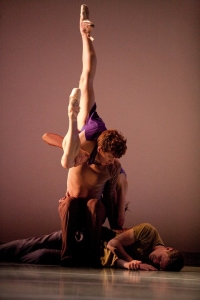***NOTE: STARTING TODAY WHIM W’HIM’S ‘BEHIND THE SCENES‘ WILL POST EARLY EACH FRIDAY, READY FOR READING WITH YOUR MORNING COFFEE!***
It’s taxing, yet can add greatly to a dancer’s flexibility and artistic maturity to work professionally with both a large artistic institution and a small dance group, says Lucien Postlewaite, who dances with both Pacific Northwest Ballet and Whim W’Him.
One good thing about belonging to a big company is that its days and weeks are highly structured. There is company class at 10:15, rehearsals at 12:05, 1:05 etc., through to 7 in the evening. You can’t say, “I don’t feel like it today or my ankle hurts.” It keeps your discipline up. You have a regular salary. And a large repertory institution—with its enormous staff plus all the supporting services like costume and scene shops—obviously can also mount works that small ones would never think of presenting.
On the other hand, in such a company, even as a principal you are one of many. Each dancer has his/her separate issues and concerns. There’s heirarchy and an etiquette to who can make what sort of suggestions. Whim W’Him is, as Andrew Bartee (also employed by both PNB and Whim W’Him) notes “a collective.” Even when the individual dancers come from quite different traditions, each is in the very center of the creative process, and the emphasis is on the contributions all can make. Whim W’Him’s mission statement, as both Andrew and Lucien point out, stresses collaboration, and every dancer has enormous input and chances to explore. “You feel a responsibility,” says Lucien. “Whim W’Him is so open and receptive to critique.”
Not surprisingly, the two experiences also involve different sorts of challenges.
The multiple jumps and turns of strict classical ballet make extreme physical demands— Lucien says he sometimes feels as if a ballet dancer only has a certain number of these in him, and each new iteration lowers the stock.
But the unusual, often complex and unexpected movements required for Whim W’Him choreography have their own kind of rigor, for the individual and in relation to other dancers. Counting can be tricky too, a quite different way of feeling the music/sound than in more traditional works. And Olivier is notoriously picky in getting the details right, as well.
I remark that if you’re one of five (as in Whim W’Him’s most recent Cast the First Stone in 2012 program), you’re 20% of the whole. That makes for a different, more participatory, maybe more integrated experience. But you also have to be on all the time. “The disadvantage with a small group,” as Lucien says, “is that if one person is late for rehearsal, or in a bad mood, or whatever, it affects everyone. It’s more bi-polar—” then he smiles and adds, “in a good way. In Whim W’Him there’s the personality of a bigger percentage. We’re all personality types that can handle and thrive on that. It matches our personalities.”
Smallness also tells, because as Lucien and Andrew agree, “Whim W’H is united by a common interest.” Each person brings something unique. “We get used to each other’s energy,” says Lucien, “but when a new person comes in, like Tory



